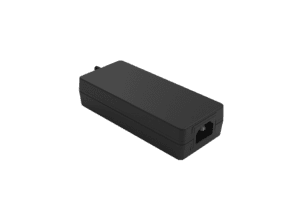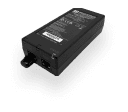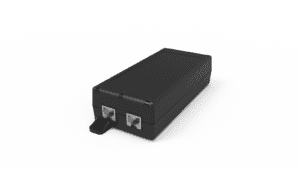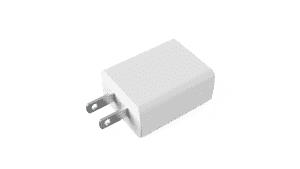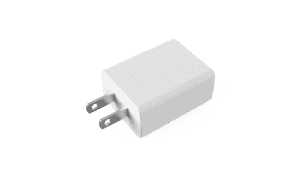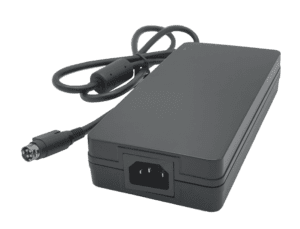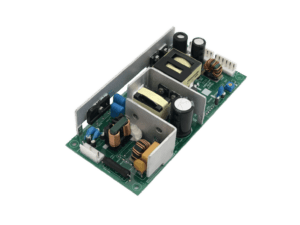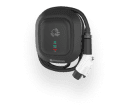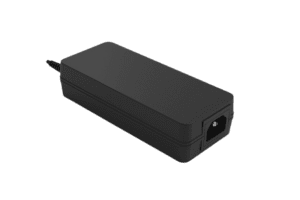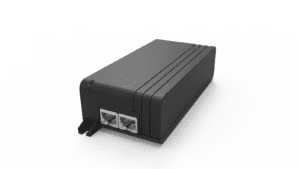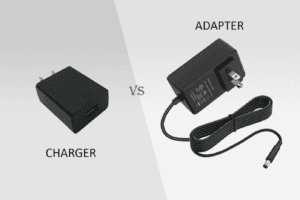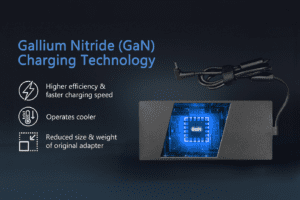BLOG
Industrial Robot Charging Station: How to Implement High-Current DC Fast Charge for Production Lines
Table of contents
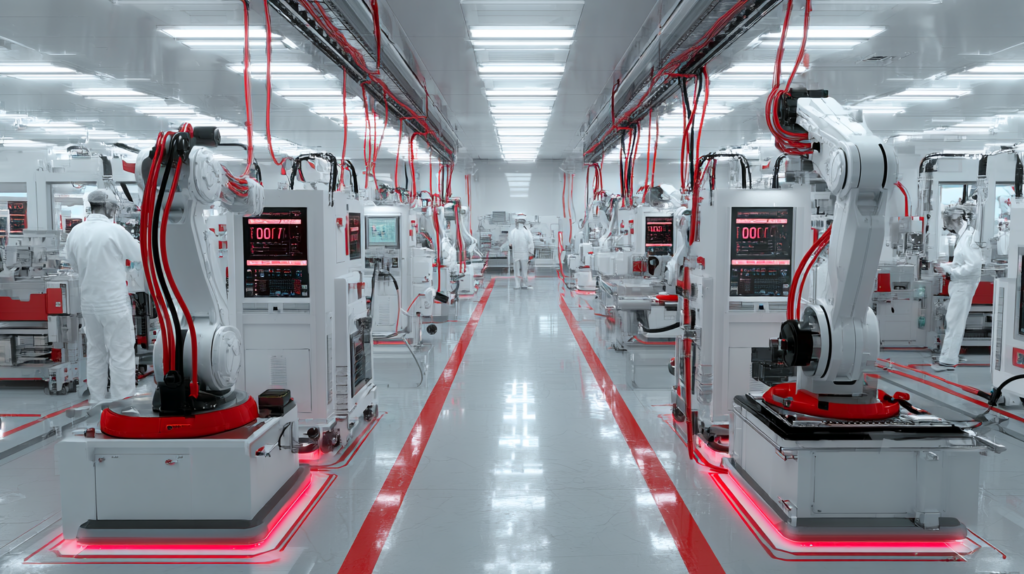
Why High-Current DC Charging Is Essential for Industrial Robotics
Industrial robots are central to modern production lines—performing welding, material handling, assembly, and palletizing tasks with speed and precision. But as these systems become more mobile, modular, and battery-operated (especially collaborative robots and AGVs), fast and reliable recharging becomes mission-critical. Unlike traditional plug-in methods or trickle charging, high-current DC fast charging ensures robots spend less time idle and more time performing.
Production lines often run 24/7, and downtime—even for charging—directly affects throughput. High-current DC systems, typically ranging from 1.5 kW to 10 kW per station, can restore significant battery capacity in under 30 minutes. This makes them ideal for opportunity charging during planned pauses like changeovers or idle station times.
High-current charging also reduces the need for battery swaps, manual charging, or centralized charging rooms—streamlining factory logistics and reducing labor demands.
Top Features
- 48 V–120 V DC output with current delivery of 30–150 A
- Programmable output profiles for lithium-ion chemistries
- CAN or RS-485 BMS integration for safe and adaptive charging
Top Benefits
- Keeps robotic systems available for more uptime per shift
- Eliminates need for manual intervention or battery swaps
- Reduces space and cabling footprint in production zones
Best Practices
- Design charging sessions around natural production pauses
- Integrate dock-ready robotics that can charge autonomously
- Use onboard charge status detection to trigger automated dock requests
High-current DC charging transforms robots from scheduled tools to continuous collaborators in smart production environments.
Engineering Power Systems for High-Speed, High-Safety Charging
Delivering high current at industrial scale requires not just powerful components but precision engineering for safety, reliability, and thermal control. DC charging modules must maintain tight voltage regulation and ripple control even under fluctuating loads, while safely managing large current surges during connection and disconnection.
To achieve this, OEMs should employ:
- High-efficiency AC-DC power converters with active PFC
- Real-time current monitoring and thermal feedback
- Isolation and protective circuitry for overvoltage, reverse polarity, and ESD
System designs must also handle voltage/current profiling for various chemistries—such as NMC, LFP, or LTO—using CC/CV logic and integrating with the robot’s battery management system (BMS) for real-time parameter adjustment.
Thermal management is another key factor. High-current systems produce more heat, so heat sinks, airflow routing, or liquid-cooled enclosures may be required, especially in high-duty-cycle environments.
Top Features
- 94–96% power conversion efficiency
- Scalable DC modules with hot-swap or parallel configuration
- Fault-tolerant safety systems with real-time protection feedback
Top Benefits
- Faster, safer charging without sacrificing battery health
- Modular power delivery that adapts to workload demand
- Predictable thermal behavior under high load
Best Practices
- Validate current ratings under full-load and over-temp conditions
- Use redundant thermal sensors to prevent overheating
- Design for peak and average load, not just nominal specs
When implemented correctly, high-current charging is not just fast—it’s stable, safe, and scalable across your entire facility.
Docking Systems That Enable Autonomous Fast Charging
Autonomous fast charging begins with precision docking hardware that can tolerate real-world conditions: dirt, vibration, wear, and misalignment. Industrial robot chargers must enable contact that is reliable, repeatable, and fast—without manual connection or oversight.
Mechanical design should feature:
- Self-aligning tapered guides or fiducial markers
- Spring-loaded pogo pins or copper contact pads
- Magnetic or assisted docking mechanisms
Charging must begin only when alignment and communication are confirmed. This prevents wear, arcing, or misconnection under high load.
For mobile industrial robots (like collaborative AMRs or robotic carts), the dock should be accessible from multiple angles and designed for high mechanical cycle life (10,000+ insertions). Fixed-position arms or rails can aid in guided alignment.
Top Features
- IP-rated contact enclosures for dirty environments
- Smart dock firmware to manage pre-charge, contact validation, and disconnect
- Real-time dock/robot communication via CAN or Modbus
Top Benefits
- Enables robots to charge themselves without human interaction
- Reduces maintenance caused by wear or alignment failure
- Supports consistent uptime across rotating workcells or lines
Best Practices
- Simulate docking cycles and contact wear during prototype validation
- Include contact cleaning logic or redundancy
- Enable charge-start only after full contact and handshake
Docking isn’t just about plugging in—it’s about ensuring a zero-failure interface between energy and autonomy.
CLIENT'S QUOTE
"Phihong’s PoE solutions have made a huge difference for us! Our network runs more efficiently, and we’ve seen real cost savings. We couldn’t be happier!"
Communication Protocols for Charging Control and Fleet Integration
Modern production environments are software-driven, and charging systems must integrate tightly with robot fleet managers, WMS systems, or MES platforms. This requires docks and chargers to support real-time communication protocols with both the robot and backend.
Common protocols include:
- CAN Bus: Reliable and widely supported for BMS communication
- RS-485 or UART: Ideal for short-range control and command
- Modbus RTU or TCP: For PLC or factory automation interface
- Ethernet/MQTT: For cloud reporting and system-level energy orchestration
Charging stations should exchange:
- Battery SoC, temperature, and cycle count
- Charging rate and estimated time to full
- Fault codes, contact quality, or temperature alerts
Optional integration with fleet managers allows dynamic charging orchestration—sending robots to charge based on workload forecasts, or balancing energy use across zones to reduce peak demand.
Top Features
- Multi-protocol interface support
- Logging and diagnostics APIs for remote monitoring
- Secure data encryption for safety-critical operations
Top Benefits
- Aligns charging behavior with production pacing
- Enables predictive maintenance and usage optimization
- Reduces downtime through smarter charge scheduling
Best Practices
- Build flexibility into communication hardware to support multiple protocols
- Encrypt control commands and robot handshakes
- Store dock and charge data for KPI dashboards
Charging isn’t isolated—it’s a part of your automated decision-making system.
Safety and Compliance Requirements for Industrial DC Charging Systems
High-current DC charging introduces safety risks that must be addressed early in design. Your charging station must meet global safety, thermal, and EMI standards to ensure both robot and worker safety—even in harsh industrial environments.
Electrical safety standards include:
- UL 2202 (EVSE and DC fast chargers)
- IEC 62368-1 or IEC 61851 (charging systems)
- Overcurrent, OVP, ESD, and insulation protection
EMC compliance includes:
- IEC 61000-4-2, -4, -5 for surge and ESD
- EN 55032 / FCC Class A for emissions
Mechanical safety covers:
- Enclosures with IP54+ ingress protection
- Arc suppression circuits and delayed contact sequencing
- Lockout mechanisms or emergency shutdown triggers
Thermal risks must also be managed with real-time monitoring and automatic shutdown if any part exceeds safe thresholds.
Top Features
- Integrated fault detection and charge abort logic
- Physical shielding of contact zones
- Compliance-ready AC-DC modules
Top Benefits
- Meets buyer and jurisdictional compliance requirements
- Reduces liability and maintenance costs
- Ensures consistent safety across deployment environments
Best Practices
- Pre-test in an EMC chamber to ensure passing margins
- Include LED or touchscreen indicators for status/fault visibility
- Design to minimize user access to live parts
Safety isn’t the last step—it’s the design philosophy that shapes every part of the charging system.
How Phihong USA Supports High-Current Industrial Robot Charging
Phihong USA is a global leader in power delivery solutions, with a proven track record in industrial charging systems for robotics, AGVs, and automation platforms. Our engineering and manufacturing capabilities help OEMs deploy high-current, intelligent, and scalable charging stations for demanding factory environments.
We offer:
- High-efficiency DC chargers from 1.5 kW to 10 kW
- Programmable voltage output with BMS communication
- Modular AC-DC power bricks with surge and EMI protection
- Dock-side firmware for handshake, monitoring, and safety logic
- Support for CAN, UART, Modbus, and MQTT integration
- Pre-compliance testing and UL/CE/FCC certifications
Our systems are designed for performance and scale—ready for rugged warehouse use, 24/7 production lines, and global logistics networks.
To start your custom charging project, visit www.phihong.com or email usasales@phihongusa.com.

Contact Our Team Today!
Our dedicated sales team and international partners are prepared to support you with your latest projects and initiatives globally.
Explore More with Phihong USA
As we conclude our exploration of PoE technology, it’s evident how these innovations are streamlining power and data integration across various industries. Phihong USA stands at the forefront of this technological advancement, offering a diverse range of power solutions designed to meet the evolving needs of modern industries.
Phihong USA’s extensive product lineup includes:
- Power over Ethernet (PoE) Solutions: Delivering reliable power and data transmission over a single cable, ideal for simplifying network installations and reducing costs.
- AC/DC Adapters and Power Supplies: From compact adapters to industrial-grade power supplies, Phihong provides solutions that ensure efficiency and reliability in various applications.
- Battery Chargers: Customizable chargers for lithium-ion and lead-acid batteries, supporting a wide range of power requirements for mobility and industrial applications.
- Medical Power Supplies: Specialized power solutions designed to meet the stringent requirements of the healthcare industry, ensuring safety and reliability.
Phihong USA is committed to innovation and excellence, continually developing products that meet the highest standards of performance and reliability. Their global reach and dedication to customer support make them a trusted partner in powering the future.
Here are some useful links to explore Phihong USA’s offerings further and bring in new potential clients:
Visit Phihong USA to discover how their advanced power solutions can support your business needs. Whether you’re looking to upgrade your network, or find reliable power supplies, Phihong USA has you covered.
By choosing Phihong USA, you’re partnering with a leader in power technology, ensuring your operations run smoothly and efficiently with top-tier power solutions. Contact Us today!
FAQ
What power levels are best for fast-charging industrial robots?
The optimal power level depends on the robot’s battery size and mission duration. Most modern industrial robots use lithium-ion batteries ranging from 1.5 kWh to 10 kWh. Fast-charging stations typically deliver 1.5 kW to 5 kW, with some high-performance robots supporting up to 10 kW. The goal is to recharge within 30–60 minutes during idle phases. Phihong’s DC chargers support programmable output to match robot specs while protecting battery health with controlled charge profiles.
How do robots safely connect to high-current DC docks?
Safe connection requires mechanical alignment aids, delayed power sequencing, and BMS communication. The robot approaches the dock using fiducials or markers, establishes contact with self-aligning pins or pads, and initiates a handshake over CAN or UART. Power only flows once safety checks pass. Disconnect procedures also safely cut current to prevent arcing. Phihong docking kits include embedded contact sensors and charge authorization firmware for zero-fault connection logic.
Can multiple robot types use the same charging station?
Yes—with modular dock design and programmable voltage/current output, multiple robot models can share a single charging system. By identifying each robot’s battery via firmware handshake, the dock applies the appropriate voltage and current. Mechanically, adapters or swappable connectors allow compatibility with different chassis and contact positions. Phihong chargers are BMS-ready and support multi-model fleets without changing hardware.
What safety standards apply to high-current industrial charging?
Key certifications include UL 2202, IEC 61851, and IEC 62368-1, along with EMC standards like IEC 61000 and EN 55032. These cover electrical isolation, overcurrent protection, EMI resilience, and safety of live contact systems. Mechanical IP ratings (IP54/IP65) are also required in most factories. Phihong power modules are engineered to meet these standards and include built-in protections to simplify your compliance path.
How does Phihong support custom robot charging deployments?
Phihong provides full-stack solutions, from modular high-wattage DC chargers to custom docking firmware and enclosure design. We work with OEMs to define electrical specs, communication protocols, and layout requirements. Our systems come pre-tested for UL/CE/FCC, with support for integration, remote diagnostics, and multi-unit scaling. Whether you’re outfitting a new line or retrofitting legacy robots, we help you deploy safe, efficient, and intelligent charging stations—on time and on budget.

